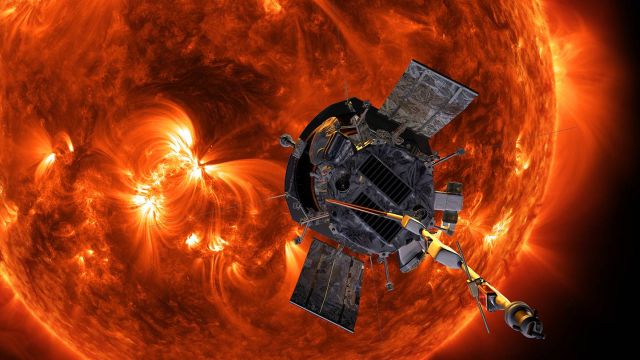
Parker Solar Probe, the NASA spacecraft that launched on Aug. 12, 2018, sped toward a second close solar approach on Sept. 1, 2019. NASA’s Goddard Space Flight Center said the solar explorer is on its third orbit around Earth.
“We’re very happy,” Nicky Fox said in a statement. “We’ve managed to bring down at least twice as much data as we originally suspected we’d get from those first two perihelion passes.” Fox is the director of NASA’s Heliophysics Division at NASA Headquarters in Washington, D.C.
On Twitter @NASASun posted
It’s #SunDay for us and for #ParkerSolarProbe! ☀️🛰 Today, the spacecraft reaches the point in its orbit closest to the Sun, called perihelion. This is the third perihelion for Parker Solar Probe, and we’re extending science observations this time around!
Scientific instruments on board gather data on the particles, solar wind plasma, electric and magnetic fields, solar radio emission, and structures in the Sun’s hot outer atmosphere, the corona.
About the size of a small car, the Parker Solar Probe spacecraft has been designed with a heat shield and a system that helps protect it from the Sun’s intense light emission but does allow the coronal material to “touch” the spacecraft.
According to NASA, collecting data from close passes of the Sun can help improve human understanding of how space weather can affect astronauts, interfere with the orbits of satellites, and how the Sun changes our space environment.
Parker Solar Probe is named for Eugene Parker, the physicist who first theorized the solar wind — the constant outflow of particles and magnetic fields from the Sun — in 1958. Parker Solar Probe is the first NASA mission to be named for a living person.
“The data we’re seeing from Parker Solar Probe’s instruments is showing us details about solar structures and processes that we have never seen before,” said Nour Raouafi, Parker Solar Probe project scientist at the Johns Hopkins Applied Physics Laboratory, which built and operates the mission for NASA. “Flying close to the Sun — a very dangerous environment — is the only way to obtain this data, and the spacecraft is performing with flying colors.”
Throughout its seven-year mission, NASA’s Parker Solar Probe will swoop through the Sun’s atmosphere 24 times, getting closer than any spacecraft has gone before. The spacecraft also holds more than 1.1 million names submitted by the public.
Back in March 2018, Americans were invited to send names to the Sun aboard humanity’s first mission to “touch” a star. A memory card holding the names was installed on the spacecraft on May 18, 2018. The card was mounted on a plaque bearing a dedication to and a quote from the mission’s namesake, Eugene Parker, who first theorized the existence of the solar wind.
This memory card also carries photos of Parker, professor emeritus at the University of Chicago, and a copy of his groundbreaking 1958 scientific paper. Parker proposed a number of concepts about how stars — including our Sun — give off material. Though our understanding of the Sun and the solar wind has vastly improved since Parker first theorized the solar wind, there are still questions left unanswered.
Parker Solar Probe will use Venus’ gravity over nearly seven years to gradually bring its orbit within 3.8 million miles of the Sun’s surface — more than seven times closer than the Helios 2 spacecraft, which came within 27 million miles in 1976.
The U.S. Army Corps of Engineers has been tasked with…
Brown and Caldwell, a leading environmental engineering and construction firm,…
Humboldt State University, one of four campuses within the California…